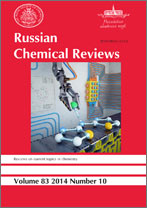|
The Periodic Law and Progress in the Study of the Structure of Matter
V. I. Gol'danskiĭ
Institute of Chemical Physics of the USSR Academy of Sciences, Moscow
Abstract:
A survey is made of the diverse achievements of Soviet scientists, rising to one of the founders of Russian chemistry – the genius D. I. Mendeleev and his greatest work – the periodic law, which has exerted an immense influence on the development of physics and chemistry at all four conceptual levels in the structure of matter – elementary particles, nuclei, atoms, and molecules. Consideration is given to the fundamental contribution made by Soviet scientists to predicting, discovering, and studying new isotopes and new types of radioactivity, to synthesising new transuranic elements and establishing their valency states (sometimes completely unexpected), and to founding the chemistry of "new atoms", in which proton and electron have been replaced by other elementary particles.
The principal modern methods for studying the structure of matter are based on the recording of hyperfine interactions between electrons and nuclei, electrons of outer and inner shells – i.e. essentially interactions between periodic and monotonic functions of the atomic numbers of the chemical elements. Soviet scientists both discovered the hyperfine interactions and made the most important contribution to their chemical utilisation (the discovery of electron spin resonance, the introduction of e.s.r. and γ-resonance spectroscopy into chemistry, the widespread application of nuclear magnetic resonance to chemistry, the establishment of photoelectronic spectroscopy in the ultraviolet and of accurate X-ray chemical spectroscopy, etc.). The work of Soviet theoretical chemists in basing the periodicity in the properties of chemical elements on the molecular orbital method is reported, and illustrates how the periodic law preserves its fertility even at the modern quantum-mechanical level of attacking the problem of chemical bonds.
A list of 157 references is included.
Citation:
V. I. Gol'danskiĭ, “The Periodic Law and Progress in the Study of the Structure of Matter”, Usp. Khim., 43:12 (1974), 2113–2145; Russian Chem. Reviews, 43:12 (1974), 1021–1042
Linking options:
https://www.mathnet.ru/eng/rcr2759https://doi.org/10.1070/RC1974v043n12ABEH001879 https://www.mathnet.ru/eng/rcr/v43/i12/p2113
|


| Statistics & downloads: |
| Abstract page: | 116 |
|





 Contact us:
Contact us: Terms of Use
Terms of Use
 Registration to the website
Registration to the website Logotypes
Logotypes







